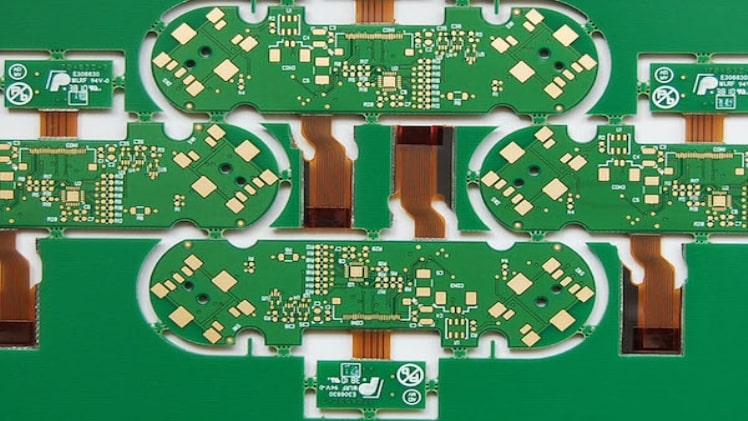The Benefits of Rigid Flex PCBs

You have probably heard about rigid flex PCBs but have not really given it much thought. What exactly is it? Where is it used? And what are the advantages of using this type of PCB? Hopefully, this article will give you some insight into this technology and help you decide if it is right for your next project. Read on to learn more about the different benefits of rigid flex PCBs and how to fabricate them.
What Is a rigid flex pcb
What is a rigid flex PCB? A rigid flex PCB is an interchanging circuit board that has layers of rigid and flexible PCBs. Its advantages include ease of installation, polarity, and polarity stability. Additionally, this type of board can be used in high-density applications. The benefits of rigid flex PCBs also make them cost-effective.
When combining flexible and rigid technologies, a rigid flex PCB can minimize the size and weight of an application. They are especially useful in applications that are subjected to high temperatures. However, rigid flex PCBs can be molded according to your specific requirements. If you have a specific requirement, you can design a rigid flex PCB in a PCB designer. This software allows you to create your own PCB, combining flexible and rigid technologies in one.
Rigid flex PCBs are also more difficult to produce than rigid ones. They are better suited for applications that don’t require wire harnesses, such as handheld thermal scanners. They also have fewer solder joints and are more durable in high-vibration environments. They can also be used for point-to-point testing, which saves assembly costs. In addition to being more rigid, a rigid flex PCB can be easily folded and inserted into tight spaces.Please visit here for information about Electron
Another major advantage of rigid flex PCBs is the flexibility of the circuit. Flexible circuits can be embedded into rigid PCBs for improved electrical performance. Because of this, rigid flex PCBs can be used to replace rigid PCBs. A rigid flex PCB also improves the flexibility of the circuitry, making it ideal for high-reliability applications. They are particularly beneficial for the electronics industry.
Where are rigid flex PCBs used?
Rigid-flex PCBs are a versatile alternative to traditional circuit boards. They combine the benefits of flexible design with high-performance electrical properties. Rigid-flex circuit boards are used for industrial, commercial, military, and medical applications. They have several benefits, including reduced product weight, increased reliability, and fewer solder joints. Learn more about this advanced technology. Here are a few examples of how these circuit boards are used today.
Rigid-flex PCBs are much lighter than traditional circuit boards, which can reduce their weight by up to 75%. They can be made of a thin polyester or polyimide material as thin as 12-120 microns, and conductive material traces are etched onto the board. Flex PCBs can have as many layers as required and are typically covered with a coverlay to prevent damage.
In addition to space-saving benefits, rigid-flex PCBs are perfect for high-density applications. Because of their ability to fold into a small profile, they are often the most cost-effective option for high-density circuit boards. And because rigid-flex PCBs are flexible, they can be maneuvered during installation. But designers must learn about rigid-flex PCB design guidelines and the tradeoff between flexibility and rigidity to get the best results from this technology.
Another important consideration in flex-flex PCBs is the ground. Rigid PCBs use solid ground as opposed to a hatched ground. Solid ground makes the board more rigid but increases its risk of cracking and breakage. A hatched ground compromises flexibility and conductivity, making it unsuitable for high-speed routing and impedance control. Rigid-flex PCBs can be a great solution for rigid-flex designs, but they should be kept away from the transition zone.
What are the advantages of rigid flex PCB?
Rigid flex circuit boards are an excellent choice for many types of electronic devices. They provide the best flexibility when it comes to circuit design, and their combined rigid and flexible properties allow them to be twisted to whatever shape is needed. As a result, rigid flex boards are ideal for high-density applications. These boards also provide the benefits of easier debugging, uniform electrical characteristics, and easy installation.
One of the main advantages of rigid flex PCBs is their ability to fit into small spaces, reducing package weight and size. The low mass of flex circuits reduces the impact of vibration and shock. Since flex circuits have less parts, they require less assembly time and reduce costs per unit. Moreover, rigid flex PCBs can be automated, reducing the need for manual testing, and reducing the overall product cost.
Rigid flex PCBs are also flexible, making them ideal for bent components. This type of circuit board can be bent to a certain degree, but careful design is essential to avoid flexing. Bend areas must be carefully designed to avoid mechanical stress that could weaken pads. In addition, traces must be routed perpendicular to the bend line, and dummy traces can be used to reinforce the bend area. When designing a rigid flex PCB, it is best to use the OrCAD PCB Designer, which is specially optimized for rigid flex design.
Rigid flex PCBs have numerous advantages. They are more lightweight and can decrease weight by as much as 75% compared to rigid PCBs. They are durable and lightweight, and they can be assembled in a streamlined economy of scale, resulting in smaller and more compact electronics. These flex PCBs are suitable for medical applications, and they also have low space requirements. They can also improve the reliability of electronic devices.
Rigid flex pcb fabrication
While rigid flex PCB may be more flexible than traditional PCB, the same quality standards must be met to ensure that it is still usable. Manufacturers must take care of cutting and welding processes, and ensure that they employ experienced staff. The process is also important to ensure that the PCB will pass final testing, such as circuit performance and quality. While cutting and welding may not be the most complex task, it requires the utmost precision and care.
The top and bottom sections of a flex PCB are protected by coverlay layers, which are cut to shape and function as solder masks for mounted components. Coverlay material is commonly a thin polyimide film, while adhesiveless processes use a photoimageable solder mask. Screen printing is also an option for coarser designs. The covercoat film is then cured under UV light, ensuring a secure connection.
After designing the PCB, the fabrication process begins. First, the laminate is removed from the board. This removes any dirt and debris that may be present in the laminate. Then, the copper coils are soldered to the PCB. A few steps must be taken to remove the anti-tarnish coating. Copper coils must be free of tarnish, otherwise they will degrade and make the PCB impossible to fabricate.
Once the rigid flex PCB is ready, the next step is to install surface components. This step is essential for the success of rigid flex PCB fabrication. Before the flex-board is laminated, it must be aligned and plated. Using a vacuum grip is an efficient method to pick up the components on a rigid flex PCB. The vacuum grip also applies the SMT to the board’s surface.
Once the laminate has been fabricated, the next step is through-hole plating. This process must be carried out with extreme precision and care. Dry photoresist film rests on the laminate. The dry photomask film is then exposed to UV light, which transfers the pattern to the laminate. Then, the copper is chemically plated to make a layer-to-layer electrical connection.
The greatest high frequency pcb manufacturer – Hemeixin Electronics Co., Limited
Hemeixin Electronics Co., Limited is one quick-turn manufacturer of prototype, various types and low volume PCBs in the world; to offer personalized one-stop solution matching the local various types and quick SMT service.Hemeixin specialize in Quick turn PCB services with an industry leading turnaround time as fast as 72 hours.




